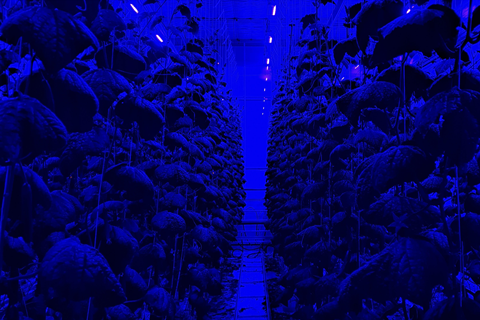Delphy collaboration explores how far-red modulation and short morning blue light can optimise cucumber growth, physiological balance, and energy efficiency

Sollum Technologies has released the results of a new case study researching the impact of dynamic LED lighting on mini-cucumber production.
Carried out in collaboration with horticultural consultancy Delphy Improvement Centre, the study explored how dynamic lighting strategies, including far-red (FR) modulation and blue supplemental morning lighting (B-SML), could impact crop balance, yield, and energy use.
The group said that the collaboration reflected it’s mission to deliver dynamic lighting solutions that adapt to each crop, helping growers meet production goals with greater precision, consistency, and efficiency.
“Cucumber is a highly light-sensitive crop that reacts strongly to the spectral composition of its growing environment,” Sollum outlined in the study.
”When transitioning from HPS to LEDs, growers often face leaf curling and reduced fitness in the absence of FR light; fruit abortion and imbalance following spectral changes; and cultivar-specific sensitivity to lighting strategies.”
The trial focused on identifying how dynamic FR management and B-SML applications could preserve plant balance and reduce energy consumption, optimise performance for different cucumber varieties, and improve physiological readiness at the start of the day.
Located at the Delphy Improvement Centre, the trial featured Uptrace and Hi Lumiere varieties of long English cucumber, with a planting density of 2.5 stems/m2, a photoperiod of 18 hours and a harvets period of 13 weeks.
“The trial began with 9 per cent FR, which was gradually reduced to 7 per cent and then 6 per cent throughout the photoperiod,” Sollum explained.
”During one week in December, FR was completely removed from 9am to 4pm – resulting in visible leaf curling and lower plant vigour.
”Two to three weeks later, fruit abortion appeared, particularly in the lower trusses,” it noted.
FR was “critical” during the darkest periods of the year to maintain cucumber plant health and productivity, Sollum confirmed.
Looking at the results, Sollum said that Uptrace yielded 21.41kg/m2 with 60.2 fruits per square metre, while Hi Lumiere yielded 26.68kg/m2 with 76.6 fruits per square metre.
”Hi Lumiere showed stronger overall performance and Light Use Efficiency (LUE) throughout the crop cycle,” Sollum pointed out. “Uptrace was more sensitive to FR withdrawal, displaying earlier signs of curling and fruit loss.
”These differences reinforce the importance of variety-specific lighting strategies under LEDs.”
In a separate protocol, researchers applied two hours of 100 per cent blue light treatment (10 µmol) in the early morning before the main photoperiod.
”This treatment improved photosystem II efficiency (PhiPSII) and influenced stomatal conductance, suggesting an increase in physiological readiness for the day,” Sollum said.
”While yield gains were not immediately evident, the data supports further investigation into B-SML as a tool for enhancing daily plant performance.”
In its study conclusions, Sollum said the trial confirmed that cucumbers could thrive under dynamic LED lighting, with ”strong performance potential” when lighting strategies were aligned with the cultivar’s unique needs.
Sollum confirmed that FR was essential during low natural light periods to prevent curling and imbalance, that dynamic spectrum adjustments could improve energy efficiency by dialling FR up or down depending on ambient conditions, and that cultivar-specific light strategies were not optional, but critical, in achieving optimal outcomes.
In addition, it said, Introducing B-SML at the beginning of the photoperiod was a ”promising strategy” for supporting plant physiology after sunrise-like lighting condition.
B-SML was the most effective in promoting the stomatal opening of the leaves before sunrise, Sollum commented, so that plants could absorb sufficient CO2 and photosynthesise immediately after exposure to higher light intensity.
”Through its dynamic LED solution and crop-specific expertise, Sollum continues to support growers with dynamic LED lighting that responds to the realities of greenhouse cultivation,” the group added.
”This cucumber trial further strengthens the collaboration between Delphy and Sollum Technologies, following the positive results achieved in our pepper production trial published in January 2025.
”Together, these studies highlight the flexibility of dynamic LED lighting strategies and their ability to drive measurable outcomes across different crops.”



